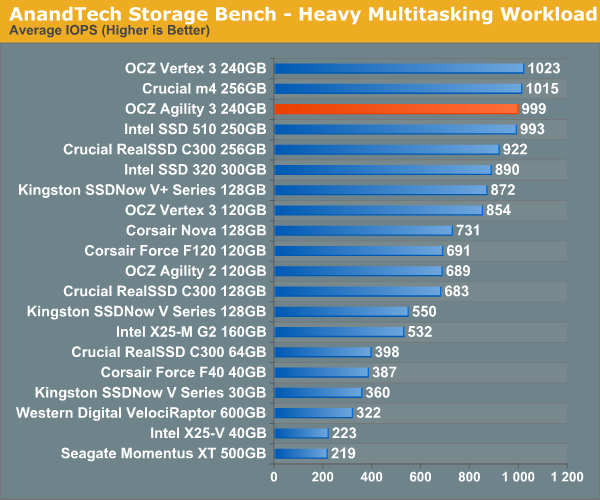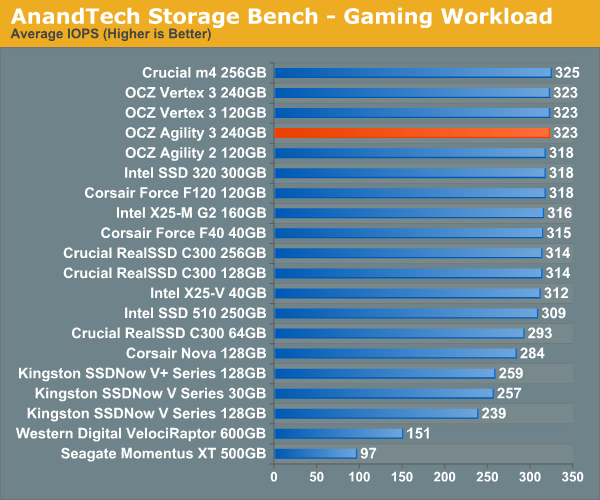OCZ Agility 3 (240GB) Review
by Anand Lal Shimpi on May 24, 2011 2:53 AM ESTAnandTech Storage Bench 2010
To keep things consistent we've also included our older Storage Bench. Note that the old storage test system doesn't have a SATA 6Gbps controller, so we only have one result for the 6Gbps drives.
The first in our benchmark suite is a light/typical usage case. The Windows 7 system is loaded with Firefox, Office 2007 and Adobe Reader among other applications. With Firefox we browse web pages like Facebook, AnandTech, Digg and other sites. Outlook is also running and we use it to check emails, create and send a message with a PDF attachment. Adobe Reader is used to view some PDFs. Excel 2007 is used to create a spreadsheet, graphs and save the document. The same goes for Word 2007. We open and step through a presentation in PowerPoint 2007 received as an email attachment before saving it to the desktop. Finally we watch a bit of a Firefly episode in Windows Media Player 11.
There’s some level of multitasking going on here but it’s not unreasonable by any means. Generally the application tasks proceed linearly, with the exception of things like web browsing which may happen in between one of the other tasks.
The recording is played back on all of our drives here today. Remember that we’re isolating disk performance, all we’re doing is playing back every single disk access that happened in that ~5 minute period of usage. The light workload is composed of 37,501 reads and 20,268 writes. Over 30% of the IOs are 4KB, 11% are 16KB, 22% are 32KB and approximately 13% are 64KB in size. Less than 30% of the operations are absolutely sequential in nature. Average queue depth is 6.09 IOs.
The performance results are reported in average I/O Operations per Second (IOPS):

If there’s a light usage case there’s bound to be a heavy one. In this test we have Microsoft Security Essentials running in the background with real time virus scanning enabled. We also perform a quick scan in the middle of the test. Firefox, Outlook, Excel, Word and Powerpoint are all used the same as they were in the light test. We add Photoshop CS4 to the mix, opening a bunch of 12MP images, editing them, then saving them as highly compressed JPGs for web publishing. Windows 7’s picture viewer is used to view a bunch of pictures on the hard drive. We use 7-zip to create and extract .7z archives. Downloading is also prominently featured in our heavy test; we download large files from the Internet during portions of the benchmark, as well as use uTorrent to grab a couple of torrents. Some of the applications in use are installed during the benchmark, Windows updates are also installed. Towards the end of the test we launch World of Warcraft, play for a few minutes, then delete the folder. This test also takes into account all of the disk accesses that happen while the OS is booting.
The benchmark is 22 minutes long and it consists of 128,895 read operations and 72,411 write operations. Roughly 44% of all IOs were sequential. Approximately 30% of all accesses were 4KB in size, 12% were 16KB in size, 14% were 32KB and 20% were 64KB. Average queue depth was 3.59.

The gaming workload is made up of 75,206 read operations and only 4,592 write operations. Only 20% of the accesses are 4KB in size, nearly 40% are 64KB and 20% are 32KB. A whopping 69% of the IOs are sequential, meaning this is predominantly a sequential read benchmark. The average queue depth is 7.76 IOs.











59 Comments
View All Comments
swaaye - Tuesday, May 24, 2011 - link
Well I guess we're in for a few year wait yet before SSDs get cheaper. Yikes. :) Come on brilliant process engineers!!!jb510 - Tuesday, May 24, 2011 - link
If I write 100 MB of compressible data to a SF drive does it use 100MB of space? Ie is it stored compressed or is that just for when it's going through the controller.If I compress or encrypt my entire drive on the fly (several utilities exist to do this) how does that affect performance?
tecsi - Tuesday, May 24, 2011 - link
We need to include the $135 60GB and $230 120GB Agility 3s to review. The $500 240GB is clearly a great performing product. But expensive. We need to understand what performance hits, other than capacity, we would take by going with the lower cost devices.Presumably the 60GB and 120GB Agility 3s will ship in much higher volume, so it important to include them in the performance charts.
JasonInofuentes - Tuesday, May 24, 2011 - link
It is logical to expect that the difference in speeds between the 240 GB Agility 3 and the 120 GB Agility 3 will mirror that of the respective Vertex 3 drives, since the structural changes are the same (two die per device vs one die per device). In real world usage, this is likely to be noticeable in some instances but not groundbreaking.seapeople - Tuesday, May 24, 2011 - link
You really must not have been very confident in your AnandTech 2011 Storage Bench if you didn't think you'd have to debut it by MAY.Seriously...
MilwaukeeMike - Wednesday, May 25, 2011 - link
That block of text describing the Storage Bench has been pasted into a bunch of reviews. Read some others and you'll see it. I don't know when it first showed up, but it was a few months ago, maybe even last year.ssd123 - Tuesday, May 24, 2011 - link
Too bad that OCZ is more interested in time-to-market than making reliable products.Check out their forums; there is no end of problems with their drives. I've personally experienced it with their Vertex 2 that would blow away my boot partition every 2 weeks or so. The replacement V2 drive they provided had the same problem.
The solutions they propose to unlucky customers range from updating BIOS, changing registry settings and updating drivers. Often, none of these fixes end up making a difference.
I love the performance of the OCZ drives, when they are working.
Unfortunately they do not deliver on the basic requirements of storage devices: they need to read and write data reliably.
I'm no Intel fanboy but I have to admit their SSDs are rock solid: they install like a regular drive and just work. No registry tuning, no driver issues, no bios problems.
OCZ has a great forums and a very engaged online community that's more than willing to help; it's a shame that they are so busy...
sanguy - Tuesday, May 31, 2011 - link
We're in the same boat - we want to use Vertex 3 (and prior Vertex 2) for one of our applications that really benefits from SSD performance but the reliability and support OCZ provides is dismal.We're using Intel G2 and G3 drives and while not as fast as the Vertex 2/3 they have been 100% reliable with ZERO issues with several hundred of them deployed.
So I love it when I see people bashing Intel - but I'd gladly give up a bit of performance for my storage to be non-volatile ;)
SG
tecsi - Wednesday, May 25, 2011 - link
We need to see performance numbers of not only $500 240GB Agility 3, but also $135 60GB and $230 120GB.These are clearly economically options for boot/app drives in desktops.
tecsi - Wednesday, May 25, 2011 - link
We need to know how the $135 60GB and $230 120GB Agility 3s fare vis-a-vis their larger, but much more expensive, $500 240GB brother.Both the 60GB and 120GB should provide ample capacity for a boot/app SSD.
This would really complete the picture.